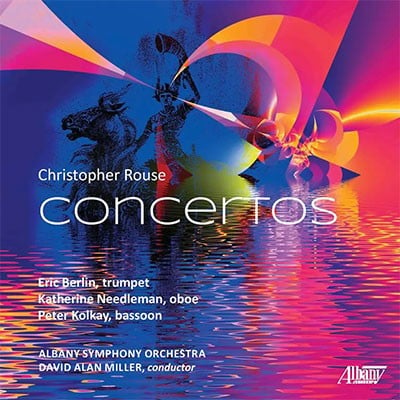2.picc(=afl).0.2.2 - 2.2.3.0 - hrp., cel., perc(3):xyl/tpl.bl/claves/tamb;tam-t/glsp/guiro/snare dr;4tom-t/susp.cym/Chin.cym/BD/wdbl - strings
Abbreviations (PDF)
Boosey & Hawkes (Hendon Music)
Since 1985 I have composed more than ten concerti, and I have noticed that they seem to fall into one of two categories: “somber” (e.g., trombone, violoncello) and “genial” (guitar, clarinet). My oboe concerto, commissioned by the Minnesota Orchestra and completed in 2004, is of the latter variety. (I used to employ the term “recreational” to refer to works of this type until I realized that it would be wrong to create the impression that composing them was a form of recreation. It isn’t; it’s hard work!)
Unlike some of my other concerti, there is no overt program to this piece. It aims of course to explore the capabilities of the oboe, of which the first in everyone’s mind is its capacity to play long, lyrical lines. However, to compose a score that would only concern itself with this aspect of the oboe would be to deny the instrument’s more virtuosic attributes, and so there are plenty of moments when the soloist is asked to play music requiring substantial agility. Notwithstanding the fast— sometimes extremely fast!— music that abounds in the work, I feel that there is an overall feeling of coloristic romanticism in the concerto, especially in the central slow movement.
It is cast in the more-or-less traditional three movement mold (fast-slow-fast) with brief and rather static slow sections at the beginning and end providing a frame for the piece. Much of the musical material in the concerto is derived from the five-note chord played by the strings at the very opening. As the music progresses, this chord undergoes a variety of metamorphoses, being used both to generate both melodic and further harmonic content.
In addition to the solo instrument, the score requires two flutes, piccolo (doubling alto flute), two clarinets, two bassoons, two horns, two trumpets, three trombones, percussion (three players), harp, celesta, and strings.
— Christopher Rouse
Reproduction Rights:
This program note may be reproduced free of charge in concert programs with a credit to the composer.

Katherine Needleman, oboe /
Albany Symphony Orchestra /
David Alan Miller
Albany TROY1979

